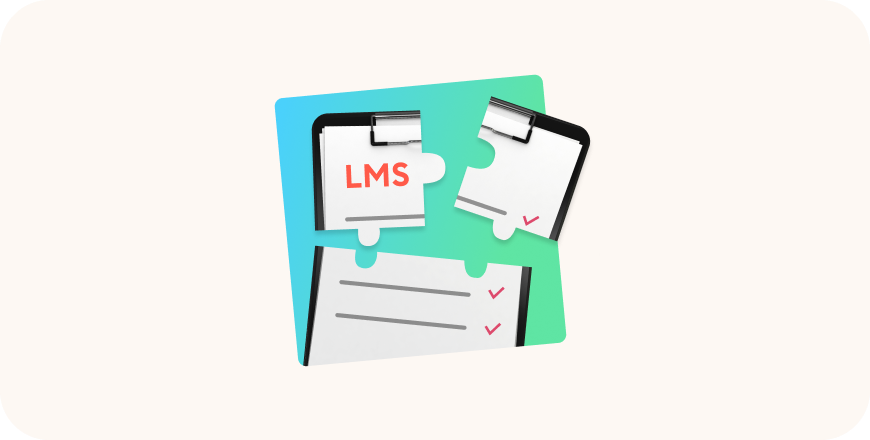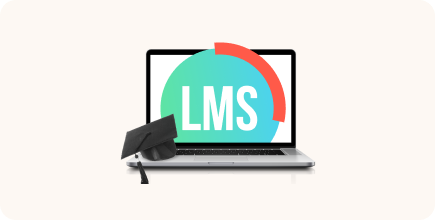LMS Migration: How to Switch an LMS and Boost eLearning

Successful LMS migration seems to be a complicated project. In fact, it’s quite similar to moving to a new house. What should you take with you and leave behind?
If you do your homework, carefully pack your belongings, and deliver them to the new place, moving is a lot easier.
What Is LMS Migration?
LMS migration is a multi-stage process of transitioning from the current LMS platform to a new one.
This includes several key steps like moving your content, users, and enrollments to a new LMS platform, exporting collected statistics from your present learning environment, creating new courses, and, of course, choosing the new learning management system. Also, there are plenty of minor steps that may vary depending on your needs: creating corporate branding, enabling integrations, customizing a mobile app, and so many more. The main goal of a successful migration is to increase business metrics through improved eLearning in the company. Quite honestly, this is a challenging process that can be expensive, and in the worst-case scenario, the company will spend money but won’t get the expected results.
Why do you need to take the risk of starting the LMS migration process at all? Well, that’s a good question. Let’s look at the cases where it’s better to change your current LMS and see what you can do to get through the migration process unscathed.
Why Migrate To a New LMS?
#1 You don’t have a single platform for all types of learning
You might use multiple eLearning authoring tools to develop training: a knowledge base, corporate intranet, social media, a service for taking quizzes, a service for conducting webinars, and so on. Sooner or later, you’ll have to face the challenge of unifying the quality of learning content and making training analytics transparent. In this case, an LMS helps to gather all the training activities in one place and create a single learning command center.
#2 Your LMS is out of date
If you use custom software, it can become outdated very quickly. This can lead to problems with the support of new eLearning content formats, an inability to use eLearning, and the collection and reporting of non-relevant metrics.
There are two options: you can either hire a full-time developer who will further customize your outdated platform or switch to a new LMS.
If you don’t update the existing LMS system for long enough, there’s a good chance that the new learning management system will boost eLearning processes and reveal new ways of eLearning in your company – whereas your existing LMS won’t.
Carefully consider all the key benefits and drawbacks of the LMS and make your choice.
#3 Your LMS is too complicated or expensive
Perhaps you’ve conducted an intro class, but users are still stumbling all the time and overwhelming administrators with questions. You can assign someone to support the users, create instructions and video tutorials on how to use your own learning management system, or transition to a more user-friendly platform.
To decide, calculate how much you spend on the maintenance of your current learning management system. You’ll be able to cut some expenses, such as tech support, if you switch to a new LMS provider who handles this type of issue.
#4 Your company is growing faster than your LMS
Let’s say you’d like to implement a new hire onboarding program, start sending training results to your corporate BI (business intelligence) system, or enroll more learners, but your current platform doesn’t have the capability to do so. In this case, you can contact your LMS provider and discuss their plans for developing the platform. Maybe you’ll be able to order a custom modification or integration through an API with a third-party service for a specific project, and that will be enough to solve your problem.
But if any of these new requirements overburden your current system, it may be time to look elsewhere and consider changing the platform.
#5 You’d like to implement innovations
LMS vendors constantly release new features. Let’s imagine you’re searching for an LMS that has a built-in collaborative authoring tool. Or you’re interested in extended functionality for social learning modules. Or maybe you’re looking for a way to integrate VR into your eLearning process and use AI tools. These features probably won’t be the top items on your LMS migration checklist, but having them would be beneficial, wouldn’t it? And potentially, this can make your work a lot easier and the learning experience more engaging and effective.
#6 Your eLearning tasks have changed
With time, you might notice that some ongoing processes are outdated. For example, your company has increased the number of training sessions. And now it’s crucial for you to integrate your LMS with Zoom or Microsoft Teams. Or you’re used to creating training content for desktops but noticed that most of the employees view courses on smartphones. And now you’re looking for a user-friendly mobile app.
In this case, it’s essential to weigh your new tasks and processes against short-term and long-term eLearning goals. Is it really so important to switch your existing LMS to a new one, or do you need to review your eLearning strategy? If your learners use smartphones to take courses, maybe it’s time to consider mLearning (mobile learning).
And so, we come to the crucial step in the LMS migration process – developing an LMS migration plan.
LMS Migration Process: a 6-Step Plan
The decision is made; your organization has outgrown its LMS or is allocating too many resources to maintenance. You’re going to swap platforms. LMS implementation can be a complicated and expensive process. You can lower the risks involved by creating an LMS migration plan. Once you’ve drawn up an LMS migration template, you can plan a soft launch.

Step 1. Create an LMS migration team
- LMS users: If you’ve used your LMS long enough, the company’s employees can definitely provide you with feedback. This is a good time to create a safe space to listen to their joys and sorrows with regard to their learning experiences. Create a user group from different departments and discuss what teachers and employees do and don’t like about your current system.
- Stakeholders: Make sure to bring key stakeholders with you to see what they expect from the eLearning process in your company.
- Task force: There’s plenty of work to do: you need to extract data, communicate with LMS vendors, create new content, and so on. To get all things done in time, assign responsibility to your coworkers for a successful LMS migration.
Step 2. Update eLearning goals
Define all the business and training needs that you want to cover after upgrading the eLearning environment in your company. What if existing eLearning goals need to be revised? This is the best moment to adopt the new strategy. Spotlight current weak points and problems. But remember that your objectives need to be realistic.
Check out our ultimate guide on LMS requirements to make a list of core features that you might need for specific eLearning goals.
Step 3. Make an LMS data migration checklist
Just like reviewing your belongings when moving, you need to choose what to take to a new system. Think about what you can “throw away,” or at least archive. To do this, make lists of all content and data.
- Users: Profiles and roles of employees, trainers, and administrators.
- Content: Training programs, files, courses, and external libraries. Note that different systems often support different types of content, and you may need to adapt your content or convert it to other formats.
- Enrollments: Ask your current vendor about the possibility of transferring existing enrollments and which statuses they support.
- Statistics: Users’ results on courses and tests, history of activities, achievements, and certificates. Decide which data can simply be exported as Excel or CSV files, and which data must be transferred directly to a new LMS.
- Branding: If you have your own branding or need to create it from scratch, discuss this with your new LMS vendor in advance.
- Backup copies: Make secondary archives of all the data in your current LMS. Backups can save your nerves (and maybe your job) if something goes wrong.
Step 4. Calculate your budget
Whether some LMSs have already drawn your attention, or you’re completely lost trying to choose the right LMS partner, your budget will definitely help you narrow down the search area. Align your priority goals with your budget and select the solution that fits your needs.
Step 5. Set timing
It’s best to set a deadline for the entire migration project. Bear in mind that your new LMS vendor might need up to 30 days or more to complete the data migration. Establish project milestones and create a migration timeline that will help you track the entire process.
Step 6. Choose a new LMS
Now, the migration process seems simpler with this step-by-step plan, doesn’t it? Finally, you can contact LMS vendors and schedule demo sessions. Sending a succinct request for proposal (RFP) to potential vendors will save you a lot of time. Read our guides to learn what questions experts advise you to ask a vendor before purchasing a new LMS and how to create a perfect LMS RFP.
Test launch
The easiest way to test a new LMS is to launch a pilot project in one of the departments. Instead of transferring all the content at once and disabling access to the previous platform, test the new LMS on a small group of users. For example, you can transfer only the content for the sales department, conduct intro training, and invite employees to take a couple of courses. This will allow you to get initial results in a day or two.
In just a month, a pilot project lets you test all the training scenarios and see if you need to fine-tune any system settings or training programs before going live.
Gather feedback from the test group
A soft launch helps you get objective feedback, find and eliminate all errors at an early stage, and make a final decision. Find out if it’s easy for users, trainers, and administrators to use the new platform and check in with your initial learning objectives.
LMS migration project plan template
To help you when preparing for an LMS migration process, we created a plan that allows you to track each step and not skip anything important. Download our ultimate LMS migration project plan template.
The Main Challenges of LMS Migration
Budget
What if you found the perfect LMS for your training but it exceeds your budget? Think about the possibility of reducing minor costs, like the use of a third-party migration service. Don’t hesitate to ask vendors about discounts when migrating from another LMS and whether the vendor will help you with the migration.
Course compatibility
This is a crucial step you need to discuss with your new LMS provider before switching platforms. It’s possible that your existing platform and the new one support different course formats. If this is the case, discuss possible solutions with your LMS provider.
Minimizing disruption
Transferring data can be a long process. To decrease your negative feedback, notify them in advance and share a timeline with an approximate date when the migration process will be completed. Also, ask prospective vendors if they have a product onboarding course that will introduce the platform to newbies.
Bottom Line
LMS migration tends to be a complicated and nerve-racking project. But it’s also a chance to improve your learning environment and help your business grow. With a solid approach and our step-by-step guidance, you can achieve good results and overcome data migration challenges smoothly.
Go ahead and book a free demo to learn more about the power of iSpring LMS to improve eLearning processes in your company. With our team of managers, developers, tech support, and eLearning geniuses, we’ll guide you through the entire migration process – from the very start to the post-implementation period. We’ll advise you on content compatibility, and if needed, our specialists from the iSpring Academy will create custom courses for your business. The Development Team will help you with LMS data migration, transfer statistics from your legacy LMS, and our Tech Support Team is eager to help you 24/7 with any tech questions that might come up during the use of the platform.







